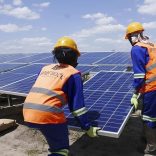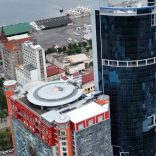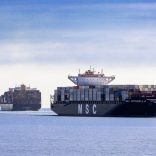TotalEnergies working on Mozambique LNG restart, CEO says
Montepuez Ruby Mining launches US$10 million resettlement project in Namanhumbir

Photo: Supplied
Cabo Delgado governor Julio Parruque yesterday laid the foundation stone of the resettlement village in Namanhumbir, Montepuez District, which will be the new home of the 105 families currently living in the village of Nthoro and are being moved as a result of a US$10 million investment by the Montepuez Ruby Mining Company (MRM).
The new village in Namanhumbir and the associated farmland will occupy an area of 2,400 hectares.
On completion, the project will have 105 residential units with water and electricity supply infrastructure, a primary school, a market, a church, a mosque, a police station, a cemetery and a waste landfill. MRM is also developing a vocational training centre as part of its ongoing US$1.2 million community development programme.
The project should be completed in about 24 months, and its start also marks the beginning of a moratorium on families claiming entitlement to relocation.
In his speech Cabo Delgado governor Julio Parruque explained that “the process seems long and time consuming, but these steps are necessary to ensure that nothing fails and that your rights and benefits are safeguarded”.
“All resettled households will receive compensation, land for agricultural resettlement and the opportunity to participate in subsistence programs,” he added.
Each family will receive a land title (DUAT) for an area of 5,000 square metres, which includes the main house, all auxiliary infrastructure and 2 hectares of agricultural land.
The vocational training centre is expected to be operational by October 2018, offering training in construction techniques to about 300 Nthoro inhabitants so that they can join locally hired workers building the new village. The training will give the inhabitants a set of skills that can be used after the project is completed, such as masonry, plumbing and carpentry.
Yesterday’s event included a visit to the model home, which shows one of the housing categories to be built in the relocation village. The model house was approved by the Government Rehabilitation Commission (CTASR) after a process of public consultation of all parties involved in the rehousing process.
MRM’s Chairman Samora Machel Junior stated that “the resettlement project now beginning is the result of thorough work dating back to the beginning of Montepuez Ruby Mining’s activities in Namanhumbir. We understood early on that it was necessary to find a stable social and economic solution for the communities living within the concession area, and for the surrounding communities too”.
Since it started operations in February 2012, MRM has mobilised about US$130 million for the construction and operation of the mine and contributed a total of US$73 million to the Mozambican government in the form of corporate taxes and duties, equivalent to 26 percent of income. The company had also, by June 30, 2017, invested more than US$1.7 million in local community development and environmental conservation. The initial development stage of operations has now reached “fully operational” status.
Why natural resource finds are more than just a curse: the case of Mozambique













Leave a Reply
Be the First to Comment!
You must be logged in to post a comment.
You must be logged in to post a comment.